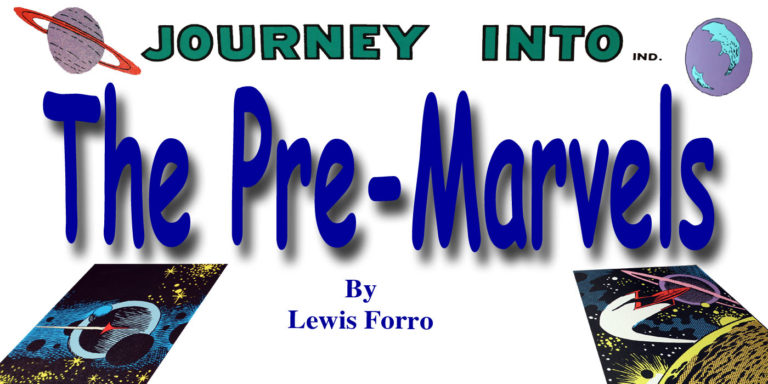
A Sci-Fi Kind of Guy
There’s another world out there more exciting than the regular mundane world where we have to spend most of our time. That’s the world of imagination as found in science fiction and fantasy books and movies. That lovely world and I have been friends almost ever since I can remember. In the early 1960s I think the first science fiction book I ever read was a library book from the White Bluff Elementary School library in Savannah, Georgia where I grew up. It was Across The Sea of Stars, an anthology by some British writer I had never heard of before, Arthur C. Clarke. About the same time I read another science anthology, The Hugo Winners Volume I, edited by an American writer I had never heard of before, Isaac Asimov. Those two books set me off on my life long journey of exploring the wonderful worlds of literary science fiction. Throughout the 1960s and early 1970s I immersed myself in reading lots of science fiction / fantasy stories and novels by Ray Bradbury and novels by Edgar Rice Burroughs. Then along came the books of Clifford D. Simak, Robert A. Heinlein and lots of others. I came full circle in the 1980s and 1990s by going back to Clarke and Asimov who hadn’t received my proper attention when I had been chasing down all the Bradbury, Burroughs and Simak I could find. I’m still exploring the vast world of literary science fiction today, just having read this summer of 2013 three anthologies by a writer I had never read much of before, Philip K. Dick.
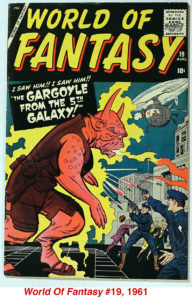
In addition to literary science fiction and fantasy I was also captivated by the world of science fiction and fantasy in film. I think it was about 1963 or 1964 when I heard the kids in White Bluff cafeteria talking about a cool science fiction movie that was coming on television this coming Saturday, something with a flying saucer and a big robot. If you’re old enough, you’ll remember a TV show called Saturday Night at the Movies on the NBC network that started at 9:00 P.M. Eastern Time, I think. It re-ran famous Hollywood movies from the old days. I remember waiting all week for that Saturday. Finally, the big moment came and I can remember my father saying something like “Ok Lewis, that movie you’ve been talking about all week is coming on now.” That was the first time I saw The Day the Earth Stood Still. I was mesmerized by it and I still am over 50 years later. Later, watching the films The War Of The Worlds and the The Time Machine on TV introduced me to the films of George Pal. Later, I later saw and enjoyed Fantastic Voyage, Planet of the Apes, 2001: A Space Odyssey new in the theaters, back when movie theaters still had big screens, comfortable plush seats, balconies and ushers. In the 1970s I fell in love with the syndicated 1960s Star Trek TV show, which is only eclipsed by the admiration for my favorite TV show, the 1960s The Twilight Zone. I watched a few Twilight Zones when they were first on TV in the early 1960s. I still remember the shock from the episode “Nightmare At 20,000 Feet” when William Shatner slides back the cover to his airplane seat window and sees that gremlin monster on the wing with its nose pressed up to the window!
And of course like many other sci-fi kind of guys, I was swept up by the Marvel Comics explosion of the 1960s. Most of Marvel’s superhero titles were technically closer to fantasy, not science fiction, but they all and especially The Fantastic Four and The Avengers had physical elements borrowed from literary science fiction such as space ships, advanced technology, robots and aliens from outer space. These sci-fi elements gave Marvel’s 1960s superhero stories a sci-fi setting and veneer, but the basic theme of the stories was still the classical dramatic conflict of good versus evil which has been the main theme of dramatic literature and story telling for thousands of years. The basic theme of science fiction literature however isn’t that dramatic conflict but the study of how humanity is affected by changes and advances in technology. But there were two periods in Marvel’s long history where Marvel had the science fiction angle covered also at least a limited extent: the Atlas era and what I call the pre-Marvel era. Both the Atlas and pre-Marvels had some comic books that featured no superheroes but only science fiction and fantasy stories. Yes, these stories mostly were the regular theme of good versus evil but they had lots of science fiction elements and many of the stories were real science fiction. The Atlas era was from the early 1951 until 1957. Marvel’s publisher Martin Goodman owned his own magazine and comic book distribution company named the Atlas News Company 1951 – 1956 which carried the Atlas Globe logo on the cover of the comic books and magazines. In 1957 Goodman used the American News Company for distribution. His comics and magazines however still carried the Atlas Globe cover logo. The American News Company went out of business in 1957. I was to young to collect Atlas comics in the 1950s and never became a big collector of them later so this article isn’t about them. Instead, this article is about the episode in Marvel’s long history that I am familiar with, the sub-species of comics known as the pre-Marvels.
What The Heck Is A Pre-Marvel?
So what the heck is a pre-Marvel? Many fans call them pre-superhero Marvels instead. Briefly, the pre-Marvels are the comics put out between the collapse of Atlas News / American News in August 1957 and the appearance of superheroes in Martin Goodman’s comic book line in the early 1960s. When the Atlas Implosion occurred in August 1957 all of Martin Goodman’s comic book line was cancelled. However he worked out a new distribution deal with Marvel’s chief rival, DC Comics, to distribute a limited number of comics each month; some sources say eight, others say 12. So in these dark days of Marvel history the company’s comic line limped along for the rest of 1957 and most of 1958 with a few romance, humor and western titles. And, three sci-fi titles from before the Implosion: Strange Tales, World of Fantasy and Journey Into Mystery with stories taken from stored inventory accumulated before the Implosion. These pre-Marvel books can be recognized by the IND logo on the upper left top corner of the cover. IND stands for Independent News Service, the distributing arm of National Periodical Publications which owned DC Comics. Then in September 1958 three new sci-fi titles appeared with new stories: Strange Worlds, Tales of Suspense, Tales To Astonish. The catalyst here were the artists Jack Kirby and Steve Ditko coming to work at Marvel full time which helped Marvel to escape the post-Implosion depression and get back on its feet again. In the summer of 1961 some of the comics started sporting another small logo on the right hand side of the cover opposite the IND cover logo, a little logo that said “Mc.” Thus was born Marvel Comics.
What I’m focusing on in this article isn’t all the pre-Marvels, or even all the sci-fi pre-Marvels, but only those sci-fi pre-Marvels when Jack Kirby and Steve Ditko came onboard in late 1958 to when superheroes completely took over the books in late 1963. The practice in the early 1960s was for Marvel to introduce a superhero as the lead feature in a sci-fi book as a test and still leave three or four sci-fi stories in the back of the book. Later, the lead superhero story would take over the entire book. Thus, four of these pre-Marvels, Strange Tales, Journey Into Mystery, Tales Of Suspense, Tales To Astonish have sci-fi stories in the back of the book that continue several months past the introduction of superheroes in those titles. So technically maybe you can claim these books with superheroes aren’t really pre-Marvels, but I still lump them in with the older pre-Marvels. That’s because the sci-fi stories in the newer superhero books have the same exact artists as the older books before superheroes thus making all of these sci-fi stories into a cohesive, recognizable body of work. Here’s the list of pre-Marvels that mark the start of the Kirby / Ditko era up to the last issue to have a sci-fi story. The dates are the cover dates, not the on sale date at the newsstand, which would be about three months earlier.
The Long Journey
As I said, I’ve been traveling down the science fiction and fantasy road for about as long as I can remember, and the pre-Marvels were right there at the beginning. In late 1959 my family was living in Elizabethtown, Kentucky and I was five years old. I know that at age 60 now memories from that long ago are usually hard to come by, but I’m sure that’s when I saw my first comic book. I was at my next door neighbor’s house during the day, on the porch or maybe the front yard and I have this clear memory of seeing a page from a comic book with an astronaut on an alien planet being chased by two dinosaur like monsters. I didn’t remember the cover of the comic book or any other pages as the years progressed from that point forward, but I had the image of that one page burned into my brain. I found out many years later that the page was the first page to a Jack Kirby drawn story “I Planted The Seeds of Doom” from Journey Into Mystery #56 cover dated January 1960. Maybe one day science will invent a machine that can probe into your oldest memories and print them out on a computer screen for verification and I’ll be proved wrong about this. But until then, I’m sticking by my story. Little did Jack Kirby know then, working away somewhere in the far away city of New York that I didn’t even know existed, that he was helping to set a little boy on the path of exploring the imagination; I’m sure Kirby did that for a lot of little boys.
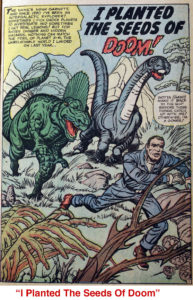
My family moved to Savannah, Georgia about 1961 and I spent part of every summer at my grandmother’s house in Tarrant City, Alabama. That’s where I came across my second pre-Marvel in late 1961. I clearly remember sitting on my grandmother’s green sofa in the quiet stillness of the night, alone, reading a story about a criminal from a utopian civilization sentenced to the Prison Planet. The last page shows him sitting on a bus after being transported to this horrible planet. He’s listening grimly to the passengers talk about all kinds of nasty stuff like disease and war that his home planet doesn’t have and it is revealed that the Prison Planet is really Earth. I remember being pleased at the surprise twist ending to the story. It took seven years to find this book again. In 1968 at Bartlett Junior High School in Savannah I bought two comic books from a friend, David Davenport: The Amazing Spider-Man #1 and Strange Tales #88 cover dated September 1961. The cover of the Strange Tales did look vaguely familiar and when I got it home and read the stories, the Prison Planet story jumped right out at me. By then I knew who the artists Jack Kirby, Steve Ditko and Don Heck were. Heck drew the Prison Planet story and I’ve always wondered why an ordinary story by an average artist like Heck would stick better in my memory over those past seven years than the better drawn, more exciting looking stories in the book by Kirby and Ditko.
The third and last pre-Marvel that I had from the primordial early 1960s was from 1962. In Savannah we had a picnic table in the back yard and my father had built a little cinder block grill of some sort in the yard so we could have outdoor cookouts. I can remember sitting outdoors at night close to the grill which still had a fire burning and reading by firelight. The comic book story had a big aquatic monsters threatening to conquer the people of Earth. The invasion plans were thwarted by a guy whose fellow humans thought he had turned traitor by pretending to help the monster invaders. The last panel shows the monsters getting ready to kill the man since it turns out he wasn’t a traitor after all. I remember feeling sorry for the guy who was going to die with his fellow man still thinking he was a traitor. I don’t remember when exactly but over the years I discovered this story “The Coming of Titan”, again drawn by Jack Kirby, was from Tales To Astonish #28 cover dated April 1962. A few months later two more tidbits came along to fuel my journey into the land of comic books: two new comic books with aliens or monsters, but they weren’t pre-Marvels. They were the first two Marvel superhero comics I owned, Fantastic Four #4 May 1962 and The Incredible Hulk #2 July 1962.
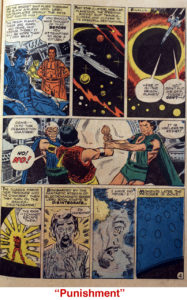
Another step in my growing awareness of the dramatic qualities of the pre-Marvels came in 1964. I visited a friend from school, Roy Davis, at his home and bought some used Marvel comic books from him. One of them had a bright red cover that caught my eye. The cover showed a muscular blonde guy in costume chained up by some ugly looking Commies. That was the first Thor comic I ever saw, Journey Into Mystery #87 December 1962. By 1964 I had read and was still holding onto a few issues of The Amazing Spider-Man and so by then I was familiar with the artist Steve Ditko who drew Spidey in those days. This JIM #87 had a Ditko story in the back after the lead Thor story. The story was “Man On A Staircase” and depicted a criminal running down an seemingly endless set of stairs; only they weren’t endless. The last panel showed him racing towards the bottom which ended in a pit of flames, apparently Hell where he would get his just punishment for a life of crime. I thought that was a pretty scary story and I noticed that the really cool Spider-Man artist, Steve Ditko, had drawn it. I figured there might be other Ditko science fiction / fantasy stories in some of the other Marvel superhero comics and it made me more determined to look for them.
In 1964 I was still a bit to young to have the maturity to be a serious comic book collector. I had just been buying a few Marvel and other comic books here and there on impulse. But I was learning who Steve Ditko and Jack Kirby were, and just how much exciting and fresh Marvel comics were compared to DC, Gold Key, Charlton and the rest. However by late 1965 I was completely seduced by Marvel comics and was firmly committed to buying nearly all of them new at my nearby 7-11 store owned by Mr. Woo, and to trying to run down all the back issues I could find. It wasn’t the pre-Marvel stories that got me into collecting Marvel comics. It was Steve Ditko drawing Spider-Man and Doctor Strange and Jack Kirby drawing the Fantastic Four, Captain America and Thor. By 1965 all four Marvel books that used to have the pre-Marvel type sci-fi / fantasy stories in the back, Journey Into Mystery, Strange Tales, Tales Of Suspense, Tales To Astonish had been replaced by the superheroes so that’s all I saw when I started collecting seriously in 1965. Some pre-Marvel collectors of today call these books the Big Four. But I was dimly aware from a few books like Journey Into Mystery #87 that those four books used to have sci-fi stories by Kirby, Ditko and Heck not that ago ago. Being a sci-fi kind of guy, I wanted to read more of those type of stories and it did help motivate me in my quest for all the Marvel back issues I had missed.
And so the journey continued. From 1965 to 1970 I used mail order dealers, primarily Robert Bell, to amass a complete collection of Marvel superhero comics from 1961 to 1965. It was quite an adventure and part of the fun was looking forward to reading all those pre-Marvel sci-fi stories in the back of the Big Four books. Like most everybody I guess, I especially wanted to read the Ditko story you knew was going to be there. Ditko and writer Stan Lee usually seemed to put more effort into making them clever and thought provoking. As a minimum, they were always at least better drawn than the Don Heck, Paul Reinman and Larry Leiber stories. Money was tight so I focused on getting mostly the superhero books like Spider-Man, Fantastic Four, Thor, Avenges, X-Men, but sometimes I would order one of the earlier issues of the Big Four before the superheroes in them came along. Robert Bell rarely had those type of books so I had to use other dealers that I found in the leading mail order fanzine of that day, The Rocket’s Blast Comic-Collector (RB&CC). I did order a few but they usually arrived in shabby condition. Not everybody graded as accurate as Robert Bell.
In 1966 a pleasant surprise came along that stimulated my interest in the pre-Marvels. I was at Mr. Woo’s 7-11 on Marvel delivery day as usual. I was going through a stack of comics just delivered but not yet put on the comic spinner rack. I can still remember how pleased I was to see a new book beckoning to me when I lifted a few books off the top of the stack. It was Fantasy Masterpieces #1, 1966. I could see that the entire book was devoted to reprints of the pre-Marvels, the first of its kind in modern days. There had been a one-shot issue of Strange Tales Annual #1 from 1962 that reprinted those type of stories but I didn’t have it and I may have not known then that book even existed. When I opened the Fantasy Masterpieces there on the inside front cover was a full page photo of Stan Lee holding a comic book and explaining in comic word balloons the contents of the book. Now that was really cool, I thought. Sadly, Fantasy Masterpieces was to good to last. After the second issue it changed format to having most of the book devoted to Golden Age reprints of Marvel’s 1940s characters like Captain America and the book was discontinued after eleven issues, but it was fun while it lasted.
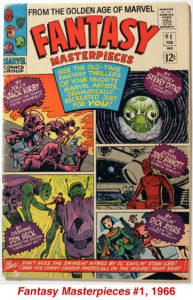
By 1970 with the acquisition of Fantastic Four #1 from Robert Bell for $30.00 my superhero Marvel comic book collection was complete in Robert Bell Very Good condition. I wasn’t prescient enough to begin upgrading the condition on those books until after 1977 when I joined the U.S. Air Force, so I was done buying superhero Marvels. But, I wasn’t done buying the Big Four pre-Marvel type books. So I bought a few here and there over the next several years, using mail order dealers from RB&CC’s successor, Alan Light’s newspaper format fanzine The Buyers’ Guide For Comic Fandom. But the going was tough. Most dealers didn’t carry them and although I wasn’t a “condition freak” in those days I was becoming more suspicious of mail order. I still wanted books in decent shape and I had been burned a few times in earlier mail order deals with low grade books. By 1977 however I did have fairly large runs of the Big Four titles in at least Very Good with a few high grade copies mixed in. By the late 1970s I was in the Air Force and stationed near Sacramento, California. I was able to visit comic book conventions in San Francisco a few times and did secure several more pre-Marvels, some in high grade. My best find among those trips was a Tales Of Suspense #2 in about Very Fine condition. I spotted on the book on a dealer’s display wall. How could I fail to spot It? It has one of the most spectacular Ditko covers in Marvel history! I was glad to pay his price of $30.00. I’ve never seen a better copy of that book since then for sale.
In the early 1980s I was stationed in San Bernardino, California where the pre-Marvel book pickings started getting juicier. I attended the San Diego Con every summer and managed to find a few high grade ones. Even at the biggest comic con in the world, high grade pre-Marvel books weren’t easy to find. I had some good luck at Redbeard’s Book Den in Newport Beach, California in 1982. The owner, Ron Pussell had a small stack of high grade apparently unread Tales Of Suspense comics that costs about $30.00 each. I had never seen that many pristine pre-Marvels in one place before. Very intoxicating! I became friends with another big mover and shaker in the comic collecting hobby, John Verzyl of Comic Heaven in Alhambra, California. John found for me in decent condition copies of two books I knew existed but never had before, Strange Tales #67 and Journey Into Mystery #50. These were the books in those venerable titles that featured new Kirby and Ditko stories instead of the post Atlas Implosion mediocre inventory stories.
It seems hard to believe now in 2013 that pre-Marvel books, even high grade ones, weren’t terribly expensive in the 1980s. While I was trying to accumulate them in the 1970s and 1980s I remember thinking to myself something like “Am I only the person who likes these books? The Marvel superhero books from the early 1960s sell for astronomical money, but the pre-Marvels from the same time or a few years earlier are much, much cheaper. Yea, the pre-Marvels don’t have superheroes in them but they have the same artists and writers like Stan Lee, Jack Kirby and Steve Ditko. Something doesn’t add up here.” I took advantage of the market mis-pricing these pre-Marvel books for close to 20 years. But as I feared, the market eventually realized its mistake and in the early 1990s the pre-Marvels started going up in price and haven’t stopped since.
In the early 1990s I was stationed in Virginia Beach, Virginia and my journey into collecting the pre-Marvels continued, but at a slower pace due to the rising prices. I quit collecting Very Good condition comics of any sort back in the 1970s and I can’t afford to buy a lot of high grade pre-Marvels, but I do what I can. In 2001 the pedigree R.J. Long collection turned up near my town. It had several high grade copies from the Big Four pre-Marvels and I did get some of those. I bought a small handful from dealer Mark Nathan at one of his rare 50% off sales at the Virginia Comic Con a few years ago. A friend, Richard Delmer also got some of the R.J. Long pre-Marvels and I’ve recently bought a few of those. So how will the long journey end? Will I ever get a complete collection of all my cherished pre-Marvels in high grade? Not likely at today’s prices. But like I said, I do what I can. I’ll be plugging away at buying the pre-Marvels in high grade for another 20 or 30 years. I’m sure of that. I’m even more sure that the more important part of the journey – the reading and savoring of all those beautiful stories that Stan, Jack and Steve did for us all those years ago – will never end until the Grim Reaper comes for me.
Critique Of The Pre-Marvels
About 240 comic books with pre-Marvel stories were produced between late 1958 and early 1964. At three to five stories per book, that’s a lot of stories! These stories make for a vast universe of wonder, violence, drama, tension and whimsy done the way that only the genius gnomes at Marvel could do them. There’s nothing quite like them in the whole history of American comic books. I’m glad that my fellow comic book collectors are aware of them; and I’m saddened that my fellow travelers in literary science fiction fandom are largely unaware of them. If you’re an old hand at collecting the pre-Marvels like me my observations below won’t be new to you. But if you’re new to the pre-Marvels and considering collecting some of them, please use what I say below for some helpful guidelines.
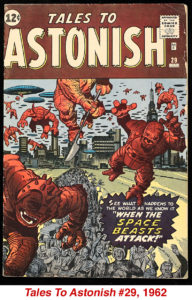
Most of the best drawn stories in the pre-Marvels are done by only two artists, Jack Kirby and Steve Ditko. The other regular artists like Don Heck, Larry Lieber, and Paul Reinman did capable work but it’s Kirby and Ditko with Stan Lee’s writing that epitomize the best of the pre-Marvels. For me, Jack Kirby’s earlier work on the pre-Marvels in Strange Worlds, Worlds Of Fantasy and the early issues of the Big Four is more entertaining than his “Big Monster” type stories. This early Kirby work dealt more with straight science fiction and was more varied and unpredictable than his more noted Big Monster stories. By early 1961 or so Kirby mostly quit doing his shorter straight science fiction stories and his Big Monsters with the funny sounding names ruled the day. You’ll find that most of these Big Monster stories are extremely formulaic but even without much suspense or dramatic tension due to the strict formulas, these Kirby Big Monster stories are still lots of fun because of the exciting illustrated Kirbyesque carnage and destruction the monster wreaks before being defeated. These Kirby Big Monster stories usually fall into two types of plots:
Type 1: A big monster alien arrives from outer space or a big monster is discovered in some remote part of the world. The monster naturally proceeds to try to conquer the world or do as much physical damage as possible within the constraints of the Comic Code Authority. The monster is rarely defeated by force but usually by the guile of a single human, kind of like David vs. Goliath. This human is frequently a henpecked husband whose wife thinks he isn’t brave or smart enough to be fighting big alien monsters. Or sometimes the human who saves the world is a misunderstood scientist who is ridiculed by his fellow scientists. Stan Lee liked the theme of the misunderstood, hated loner who never-the-less takes on the responsibility to help his fellow man when danger threatens. So all these henpecked husbands are sort of early versions of Spider-Man or the X-Men. There is no suspense or tension derived from wondering if the monster will be victorious. He never is. But you can have some fun trying to guess what type of gimmick or trick the human will use to defeat him.
Type 2: A big monster alien arrives from outer space. He never looks like Cary Grant or Robert Redford, so everyone on Earth assumes he is a menace. The monster is attacked but meanwhile one sympathetic human figures out that the monster isn’t a menace but a potential friend who can benefit mankind. The monster is driven off and the benefits of his friendship are lost to Earth. Then the sympathetic human gets to make a noble speech about how stupid and intolerant humanity is. In a few stories, the monster before leaving bestows some benefit on the human who understood and befriended him.
Recommendation: If you are a Jack Kirby fan, read all the Big Monster stories. They’re like peanuts or potato chips; you can’t stop once you start. If you’re not a big Kirby fan or comic book fan, but more of a straight science fiction fan, just read the pre-1961, shorter Kirby sci-fi stories. They’re not as formulaic and deal with regular science fiction themes and ideas.
For me, Steve Ditko is the main reason for exploring the pre-Marvels. You’ll probably agree that’s true for you too. The Kirby Big Monster story was usually the first and longest story in all the pre-Marvels, but then there were still three or four more shorter stories to go that had to be something besides a big monster threatening the world. Stan Lee and the other writers had to rely on different science fiction and fantasy themes and plots for these stories. The main goal was to surprise or shock the reader with an unexpected twist ending, like the old time writers O. Henry and Saki and the contemporary The Twilight Zone TV show that was on TV almost the exact same time period as the pre-Marvel comic book era. Lee and Ditko were especially good at these type of stories. They were so good at it they even made it a point to put a single comic book that featured nothing but Lee / Ditko twist ending stories, Amazing Adult Fantasy. Ditko handled these science fiction and fantasy twist ending plots in his wonderfully unique style. He was better at artistic composition than Kirby and the characters in Ditko stories showed a wider range of facial expressions than Kirby, allowing for more emotions to be shown. Ditko used his talent for composition and evoking emotion to render all sorts of spooky, eerie, unnerving situations for his characters to have to contend with. Even if the plots were repetitive and formulaic, there was much pleasure in just looking at the self contained bizarre worlds created by Ditko for each story. And yes, like Kirby’s Big Monster stories, Ditko was constrained by having to work frequently with a limited number of house plots. Even genius-level creators like Lee and Ditko couldn’t be brilliantly original in every story when they were having to grind them out like sausages on an assembly line. Below is a list of the most common Lee / Ditko plots. If you read at least two or three pre-Marvel comics, you will most likely encounter them all, more than once.
1.) Bad Guy Gets His Comeuppance plot: This plot accounts for at least 50% of the Lee / Ditko plots. The typical example shows a greedy businessman, corrupt dictator, venal criminal and other unsavory sorts who are looking for the usual stuff, money or power. They hear about a gypsy fortune teller, curio shop owner or secluded old hermit and go to see him or her to extort from them what the Bad Guy wants. The apparently helpless old gypsies et al use their supernatural powers to pull the rug out from under the Bad Guy, by giving him what he wants but not the way he wanted it. Check out the The Twilight Zone and Alfred Hitchcock Presents for the TV versions of this plot.
2.) Thwarted Alien Invasion plot: If you need to show aliens conquering the Earth, your go-to artist was Jack Kirby. But if you only needed to show aliens plotting to conquer Earth, Steve Ditko was your man. This plot is probably about 20% of the Lee / Ditko plots. The typical story shows the aliens planning to invade Earth. They send one of their own, frequently disguised as a human, to make sure the Earthmen are weak enough to conquer. Don’t worry about Earth, the aliens nearly always failed. One of two things happened. First, like Kirby’s clever henpecked husbands, a smart Earthman outwits the aliens by convincing them Earth is too powerful to be messed with. Or, second the aliens are so stupid they misinterpret what they see on Earth and convince themselves to give up the invasion.
3.) Size Relativity plot: This plot is about 5% of the Lee / Ditko plots. We see a giant monster or alien making life miserable for the people or creatures under his control. But then the monster gets washed away by a rainstorm. The last panel in the story shows a lab technician washing off a microscope slide. The big monster was just a speck of dust in a micro-universe. A variation of this plot shows an apparently human scientist claiming that that there are smaller worlds inside the regular world everybody is living in. He drinks the usual formula and finds himself shrinking down through ever smaller and smaller worlds until he arrives at the smallest place possible, Earth. Again, check The Twilight Zone for the TV version of these plots.
4.) Don’t Mess Around With Time Machines plot: These are among my personal favorites in the Lee / Ditko oeuvre and are about 10% of their plots. A corrupt Bad Guy seeking the usual power or money steals or builds a time machine, or a curious scientist just wants to visit the past or future to seek knowledge or a way to help mankind. Usually nothing good comes of it. The Bad Guy gets his comeuppance and the curious scientist is frustrated or disappointed. These type of stories gave Lee and Ditko a chance to put their own spin on the familiar time travel paradoxes and problems that the mainstream science fiction writers had been fiddling with since the 1930s.
If you can find a Lee / Ditko story that doesn’t fall into these four widely used house plots, it’s probably a much better than average, thought provoking story. Personally, I don’t care much how repetitive the basic Lee / Ditko plots were. Reading Lee’s snappy, dramatic dialogue and looking at Ditko’s beautiful, surreal art is enough to satisfy me. If they managed to put a little extra different spin on a tired old house plot or sometimes shine through with a plot that was fresh and original, so much the better.
Recommendation: If you’re a serious comic book or science fiction fan you already know what to do. Read all the Lee / Ditko pre-Marvel stories you can get your hands on. If you’re less dedicated, at least read the Amazing Fantasy Omnibus hardcover book published a few years ago. It has all the Lee / Ditko stories for Amazing Adult Fantasy #7 – #14. Consider this book to be Stan and Steve’s Greatest Hits album.
Below is a link to a page of sample photos of pre-Marvel stories with comments to show how Steve Ditko’s art style evolved and how he and Stan Lee handled various science fiction ideas and plots in those stories.

A fantastic article. This site is a goldmine of info and anecdotes from the good old days of Comic Fandom. GOD BLESS….
-jimbo(a friend of jesus)
Thanks Jim.
Interesting, a bit long-winded, but fascinating reading!